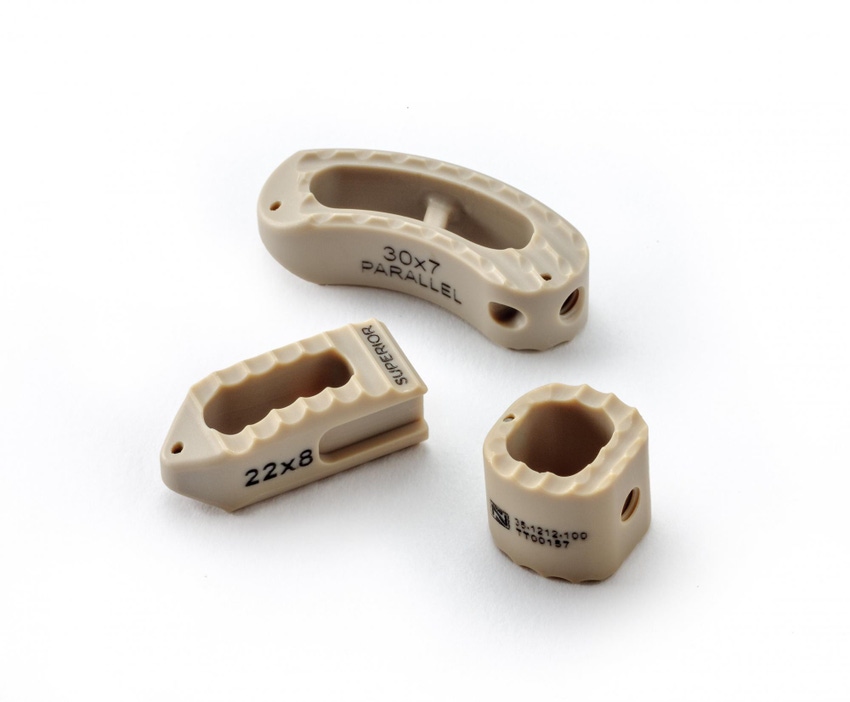Use of plastics in medical implants is soaring
Visit the Web sites of some of the biggest and best known plastics companies and you may see a bold-faced announcement: "Our products are not for use in any human implantable applications."That's been the case for more than 15 years, since an explosion of malpractice lawsuits involving breast and temporomandibular (TMJ) joint implants. For deep-pocketed chemical companies, the risk was too great and the potential reward too low for the relatively low-volume implant applications.
October 17, 2012

Visit the Web sites of some of the biggest and best known plastics companies and you may see a bold-faced announcement: "Our products are not for use in any human implantable applications."
That's been the case for more than 15 years, since an explosion of malpractice lawsuits involving breast and temporomandibular (TMJ) joint implants. For deep-pocketed chemical companies, the risk was too great and the potential reward too low for the relatively low-volume implant applications.
|
PEEK spinal implants. (Solvay) |
But times are changing, in part because of the very high prices that can be charged for implantable plastics and the growing market size. One observer, Larry Acquarulo, CEO of Foster Corp., says that the 1998 passage of the Biomaterials Access Assurance Act in an effort to protect implant material suppliers from civil liability has helped fuel interest from major chemical companies. Foster is a compounder of custom materials for implantable applications.
Victrex was a leader in establishing an early, strong position in the implantables market. Polyetheretherketone (PEEK) has been an attractive material due to its biocompatability, relative inertness, strength, and other mechanical properties.
When ICI launched Victrex PEEK in 1987 the primary focus was on nonmedical applications. But as with many engineering plastics, Victrex PEEK was used, if not supported or approved, for implant applications. That changed when ICI sold the Victrex PEEK business and in 1998 Victrex launched PEEK-OPTIMA for long-term implantable applications. In 2001 Victrex launched Invibio Biomaterial Solutions to further its implantable business.
Another milestone came at K 2007 when European chemical giant Solvay announced its Solviva biomaterials business for implantable applications. One of its tag lines is that it has "more to offer than PEEK." Plastics offered include Zeniva PEEK, Proniva self-reinforced polyphenylene (SRP), Veriva polyphenylsulfone (PPSU), and Eviva polysulfone (PSU). Other plastics are also used in implants, including ethylene vinyl acetate (EVA and highly cross-linked ultra-high molecular weight high-density polyethylene for orthopedic applications.
"The use of polymers in temporary and permanent implant devices is rapidly growing," says Acquarulo. "Material suppliers who strategically positioned themselves for this market ten years ago have benefited and paved the way for new suppliers and materials today. FDA 510(k) clearances of PEEK related devices are an excellent example. Companies introducing a new medical device for human use in the US market must first receive clearance from the FDA, the most common process is referred to as a 510(k). In 2001 there was only one FDA 510(k) clearance with PEEK polymer featured in the registered name of an implantable device. In 2011 there were 17 such clearances, and this year there were six in the first quarter alone."
The number of U.S. patents for bioresorbable and medical grew from 48 in 2005 to 311 in 2011, a rise of 548%, according to a database search by Foster. There have been 229 patents for bioresorbables issued year to date.
Complaints about high costs
Cost of the specially qualified materials has been a significant issue, however.
Plastics producers keep an extremely tight lid on prices of implantable grades such as PEEK, and require customers to sign secrecy agreements on pricing. But costs occasionally leak out due to complaints from users. Medical-grade PEEK can easily cost more than $1000 per pound and specialty bioresorbables can be much higher than that.
Stephen L. Rouse, DDS, a government contractor working in the 3-D Medical Applications Lab at Walter Reed Army Medical Center, wanted to use PEEK in an additive manufacturing process to make cranial implants for severely wounded soldiers. But high costs were a factor in choosing alternative materials.
Medical device design engineer Len Czuba also feels that pricing of implantable grade plastics has risen too high.
"The whole issue is, does the material really justify that kind of pricing? They could probably sell it for half of what they are selling it and still make a tremendous profit," Czuba said in an interview with PlasticsToday.
Victrex has declined to comment on pricing issues. But Shawn Shorrock, Solvay's global healthcare manager, responded that the Solviva materials are "manufactured on dedicated assets, with strict adherence to validation, traceability and control. The governing quality-management system is based in ISO 13485, the same quality manufacturing system that is used by medical device manufacturers. Six of the largest medical device manufacturers have audited our production system. They want these types of controls in place. Then we have done complete, extensive biological evaluation and chemical characterization of these materials. We maintain a Master Access File with the FDA to support regulatory submissions on these products. Responsible OEMs want materials with high quality, tight manufacturing controls, traceability, and know that using materials without these controls means the introduction of significant risks. The higher prices for these materials are justified by the higher costs to produce them."
Acquarulo says that the specialized grades and enhanced testing protocols are an important way that resin producers are mitigating risk. Foster estimates that nine out of every 10 custom formulations require reporting of end-use application to a material supplier for at least one of the constituents.
You May Also Like



